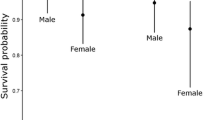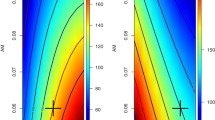Abstract
Understanding the effect of protection measures on recovery of endangered populations is crucial for assessing the efficiency of management plans. Following the ban of DDT, PCB and other detrimental chemicals in the 1970s, the German white-tailed eagle population recovered rapidly. Using nest monitoring data, dead recovery data and population dynamics models, we examined both short and long-term viabilities of the population. Between 1991 and 2005 the proportion of breeding pairs with an active nest among territorial pairs was α = 0.88 ± 0.007. Annual breeding success was γ = 0.62 ± 0.014. Mean fledged brood size was b = 1.50 ± 0.010 fledged/successful breeding pair. The analysis of dead recovery data of 1,273 individuals ringed as nestling between 1991 and 2006 allowed survival rates to be estimated. We needed to distinguish between “young” (5 years old) and “old” (older than 5 years) adults. Furthermore the annual survival rate was higher for juvenile and immature birds (0.921 ± 0.024) than for adults (s “young” = 0.760 ± 0.097 and s “old” = 0.875 ± 0.079), a pattern presumably explained by territorial fights. Finally, an age structured model was used to examine the joint effect of population regulation, environmental and demographic stochasticities. All results indicated that only pessimistic scenarios could lead to substantial extinction probabilities within 100 years. We conclude that management measures were successful in removing the main extinction factors of the population and that future conservation efforts need to focus on the remaining ultimate extinction causes.



Similar content being viewed by others
References
Alcala AC (1988) Effects of protective management of marine resources on fish abundances and fish yields in the Philippines. Ambio 14:194–199
BirdLife International (2005) Haliaeetus albicilla. In: 2007 IUCN red list of threatened species. http://www.iucnredlist.org. Cited 13 Oct 2008
Burnham KP, Anderson DR (eds) (1998) Model selection and multimodel inference: a practical information-theoretic approach. Springer, New York
Catchpole EA, Freeman SN, Morgan BJT (1995) Modelling age variation in survival and reporting rates for recovery models. J Appl Stat 22:597–610
Caughley G (1994) Directions in conservation biology. J Anim Ecol 63:215–244
Cormack RM (1970) Statistical appendix. In: Fordham RA, Cormack RM (eds) Mortality and population change of Dominican gulls in Wellington, New Zealand. J Anim Ecol 39:13–27
Coulson T, Mace GM, Hudson E, Possingham H (2001) The use and abuse of population viability analysis. Trends Ecol Evol 16:219–221
del Hoyo J, Elliott A, Sargatal J (1994) Handbook of the birds of the world, vol 2, Lynx edn, Barcelone
Einvik K (1989) White-tailed sea eagle drama on the Namdal Coast. Vår Fuglefauna 12:118–119
Evans RJ, Wilson JD, Amar A, Douse A, Maclennan A, Ratcliffe N, Whitfield DP (2009) Growth and demography of a re-introduced population of white-tailed eagles Haliaeetus albicilla. Ibis 151:244–254
Ferrière R, Sarrazin F, Legendre S, Baron JP (1996) Matrix population models applied to viability analysis and conservation: theory and practice using the ULM software. Acta Oecologica 17:629–656
Fischer W (1984) Die Seeadler. Spektrum Akademischer Verlag, Heidelberg
Fisher IJ, Pain DJ, Thomas VG (2006) A review of lead poisoning from ammunition sources in terrestrial birds. Biol Conserv 131:421–432
German Federal Agency for Nature Conservation (2006) http://www.bfn.de/0322_seeadler.html. Cited 14 Oct 2008
Green RH (1979) Sampling design and statistical methods for environmental biologists. Wiley, New York
Green RE, Pienkowski MW, Love JA (1996) Long-term viability of the re-introduced population of the white-tailed eagle Haliaeetus albicilla in Scotland. J Appl Ecol 33:357–368
Hauff P (1998) Population development of white-tailed eagle Haliaeetus albicilla in Germany since 1980 with a review of the past 100 years. Vogelwelt 119:47–63
Hauff P (2003) Sea-eagles in Germany and their population growth in the 20th century. In: Helander B, Marquiss M, Bowerman W (eds) Sea eagle 2000, conference proceedings of the Swedish society for nature conservation, Stockholm, 13–17 September 2000, pp 71–77
Hauff P, Mizera T (2006) Verbreitung und Dichte des Seeadlers Haliaeetus albicilla in Deutschland und Polen: eine aktuelle Atlas-Karte. Vogelwarte 44:134–136
Helander B (2003a) The white-tailed sea eagle in Sweden—reproduction, numbers and trends. In: Helander B, Marquiss M, Bowerman W (eds) Sea eagle 2000, conference proceedings of the Swedish society for nature conservation, Stockholm, 13–17 September 2000, pp 57–66
Helander B (2003b) The international colour-ringing programme—adult survival, homing, and the expansion of the with-tailed sea eagle in Sweden. In: Helander B, Marquiss M, Bowerman W (eds) Sea eagle 2000, conference proceedings of the Swedish society for nature conservation, Stockholm, 13–17 September 2000, pp 145–154
Helander B, Mizera T (1997) White-tailed eagle. In: Hagemeyer WJM, Blair MJ (eds) The EBCC atlas of European breeding birds: their distribution and abundance. Poyser, London, pp 136–137
Helander B, Olsson A, Bignert A, Asplund L, Litzén K (2002) The role of DDE, PCB and eggshell parameters for reproduction in the white-tailed sea eagle (Haliaeetus albicilla) in Sweeden. Ambio 31:386–403
Jiguet F, Robert A, Micol T, Barbraud C (2007) Quantifying stochastic and deterministic threats to island seabirds: last endemic prions face extinction from falcon peregrinations. Anim Conserv 10:245–253
Kenntner N, Tataruch F, Krone O (2001) Heavy metals in soft tissue of white-tailed eagles found dead or moribund in Germany and Austria from 1993 to 2000. Environ Toxicol Chem 20:1831–1837
Köppen U (2003) Ringing and colour-marking of white-tailed eagles in Eastern Germany—results, experiences and future tasks. In: Helander B, Marquiss M, Bowerman W (eds) Sea eagle 2000, conference proceedings of the Swedish society for nature conservation, Stockholm, 13–17 September 2000, pp 169–179
Krebs CJ (1991) The experimental paradigm and long-term population studies. Ibis 133:3–8
Krone O, Langgemach T, Sömmer P, Kenntner N (2003) Causes of mortality in white-tailed sea eagles from Germany. In: Helander B, Marquiss M, Bowerman W (eds) Sea eagle 2000, conference proceedings of the Swedish society for nature conservation, Stockholm, 13–17 September 2000, pp 211–218
Lande R (1993) Risks of population extinction from demographic and environmental stochasticity and random catastrophes. Am Nat 142:911–927
Legendre S, Clobert J (1995) ULM, unified life models, a software for conservation and evolutionary biologists. J Appl Stat 22:817–834
Legendre S, Clobert J, Møller AP, Sorci G (1999) Demographic stochasticity and social mating system in the process of extinction of small populations: the case of passerine introduced to New Zealand. Am Nat 153:449–463
Love JA (1983) The return of the sea eagle. Cambridge University Press, Cambridge
Mace GM, Lande R (1991) Assessing extinction threats: toward a re-evaluation of IUCN threatened species categories. Conserv Biol 5:148–157
Mangel M, Tier C (1994) Four facts every conservation biologist should know about persistence. Ecology 75:607–614
Margalida A, González LM, Sánchez R, Oria J, Prada L, Caldera J, Aranda A, Molina JI (2007) A long-term large-scale study of the breeding biology of the Spanish imperial eagle (Aquila adalberti). J Ornithol 148:309–322
Martínez JA, Calvo JF, Martínez JE, Zuberogoitia I, Zabala J, Redpath SM (2008) Breeding performance, age effects and territory occupancy on a Bonelli’s eagle Hieraaetus fasciatus population. Ibis 150:223–233
McClanahan TR, Kaunda-Arara B (1996) Fishery recovery in a coral-reef marine park and its effect on the adjacent fishery. Conserv Biol 10:1187–1199
Mebs T, Schmidt D (eds) (2006) Die Greifvögel Europas, Nordafrikas und Vorderasiens. Kosmos, Stuttgart
Mizera T (2003) White-tailed sea eagle in Poland. In: Helander B, Marquiss M, Bowerman W (eds) Sea eagle 2000, conference proceedings of the Swedish society for nature conservation, Stockholm, 13–17 September 2000, pp 79–83
Morris WF, Doak DF (2002) Quantitative conservation biology: theory and practice of population viability analysis. Sinauer, Sunderland, Massachusatts
Newton I (1979) Population ecology of raptors. Poyser, Berkhamsted
Nygård T, Kenward RE, Einvik K (2000) Radio telemetry studies of dispersal and survival in juvenile White-tailed sea eagles Haliaeetus albicilla in Norway. In: Chancellor RD, Meyburg B-U (eds) Raptors at risk. London, World working group of birds of prey, pp 487–497
Pimm SL (1996) Lessons from a kill. Biodivers Conserv 5:1059–1067
Ricklefs RE (2000) Density-dependence, evolutionary optimism, and the diversification of avian life histories. Condor 102:9–22
Sæther BE, Bakke O (2000) Avian life history variation and contribution of demographic traits to the population growth rate. Ecology 81:642–653
Saurola P, Stjenberg T, Högmander J, Koivusaari J, Ekblom H, Helander B (2003) Survival of juvenile and sub-adult Finnish white-tailed sae eagles un 1991–1999: a preliminary analysis based on resightings of colour-ringed individuals. In: Helander B, Marquiss M, Bowerman W (eds) Sea eagle 2000, conference proceedings of the Swedish society for nature conservation, Stockholm, 13–17 September 2000, pp 155–167
Seber GAF (1970) The effects of trap response on tag recapture estimates. Biometrics 26:13–22
Shaffer M (1987) Minimum viable populations: coping with uncertainty. In: Soulé ME (ed) Viable populations for conservation. Cambridge University Press, Cambridge, pp 69–86
Skarphédinsson KH (2003) Sea eagles in Iceland: population trends and reproduction. In: Helander B, Marquiss M, Bowerman W (eds) Sea eagle 2000, conference proceedings of the Swedish society for nature conservation, Stockholm, 13–17 September 2000, pp 31–37
Skonhoft A, Yoccoz NG, Stenseth NC, Gaillard JM, Loison A (2002) Management of chamois (Rupicapra rupicapra) moving between a protected core area and a hunting area. Ecol Appl 12:1199–1211
Stjernberg T, Koivusaari J, Högmander J (2003) Population trends and breeding success of the white-tailed sea eagle in Finland, 1970–2000. In: Helander B, Marquiss M, Bowerman W (eds) Sea eagle 2000, conference proceedings of the Swedish society for nature conservation, Stockholm, 13–17 September 2000, pp 103–112
Struwe-Juhl B (2003) Age-structure and productivity of a German white-tailed sea eagle population. In: Helander B, Marquiss M, Bowerman W (eds) Sea eagle 2000, conference proceedings of the Swedish society for nature conservation, Stockholm, 13–17 September 2000, pp 181–190
Swenson JE, Alt KL, Eng RL (1986) Ecology of bald eagles in the greater Yellowstone ecosystem. Wildl Monogr 95
Tucker GM, Heath MF (1994) Birds in Europe: their conservation status. Biological Conservation Series No 3, Birdlife International, Cambridge
Volke V, Randla T (2003) Population trends of the white-tailed eagle in Estonia in the 1990s. In: Helander B, Marquiss M, Bowerman W (eds) Sea eagle 2000, conference proceedings of the Swedish society for nature conservation, Stockholm, 13–17 September 2000, pp 97–101
Walls SS, Kenward RE (1998) Movements of radio-tagged buzzards Buteo buteo in early life. Ibis 140:561–568
Watts BD, Therres GD, Byrd MA (2008) Recovery of the Chesapeake Bay bald eagle nesting population. J Wildl Manage 75:152–158
White GC, Burnham KP (1999) Program MARK: survival estimation from populations of marked animals. Bird Study 46:120–139
White GC, Franklin AB, Shenk TM (2002) Estimating parameters of PVA models from data on marked animals. In: Beissinger SR, McCullough DR (eds) Population viability analysis. University of Chicago Press, Chicago
Whitfield DP, Fielding AH, Whitehead S (2008) Long-term increase in the fecundity of hen harriers in Wales is explained by reduced human interference and warmer weather. Anim Conserv 11:144–152
Wille F (2003) Status of the white-tailed sea eagles in Greenland, 2000. In: Helander B, Marquiss M, Bowerman W (eds) Sea eagle 2000, conference proceedings of the Swedish society for nature conservation, Stockholm, 13–17 September 2000, pp 27–29
Willgohs JF (1961) The White-tailed Eagle Haliaeetus albicilla (Linné) in Norway, Univ. Bergen. Arb Mat-naturv 12:1–212
Zimmerman GS, Gutiérrez RJ, Lahaye WS (2007) Finite study areas and vital rates: sampling effects on estimates of spotted owl survival and population trends. J Appl Ecol 44:963–971
Acknowledgments
We thank the Federal Ministry of Education and Research of Germany (BMBF) for financing this study and the Project Management Juelich (PtJ) for administrating the project. We are grateful to the Hiddensee Bird Ringing Centre and all people involved in the International White-Tailed Eagle Colour-Ringing Programme in Germany for ringing, collecting of reproduction data and monitoring. We thank also the associate editor, two anonymous referees and Jean-Dominique Lebreton for their helpful comments and suggestions to earlier versions of this manuscript.
Author information
Authors and Affiliations
Corresponding author
Electronic supplementary material
Below is the link to the electronic supplementary material.
Rights and permissions
About this article
Cite this article
Sulawa, J., Robert, A., Köppen, U. et al. Recovery dynamics and viability of the white-tailed eagle (Haliaeetus albicilla) in Germany. Biodivers Conserv 19, 97–112 (2010). https://doi.org/10.1007/s10531-009-9705-4
Received:
Accepted:
Published:
Issue Date:
DOI: https://doi.org/10.1007/s10531-009-9705-4




